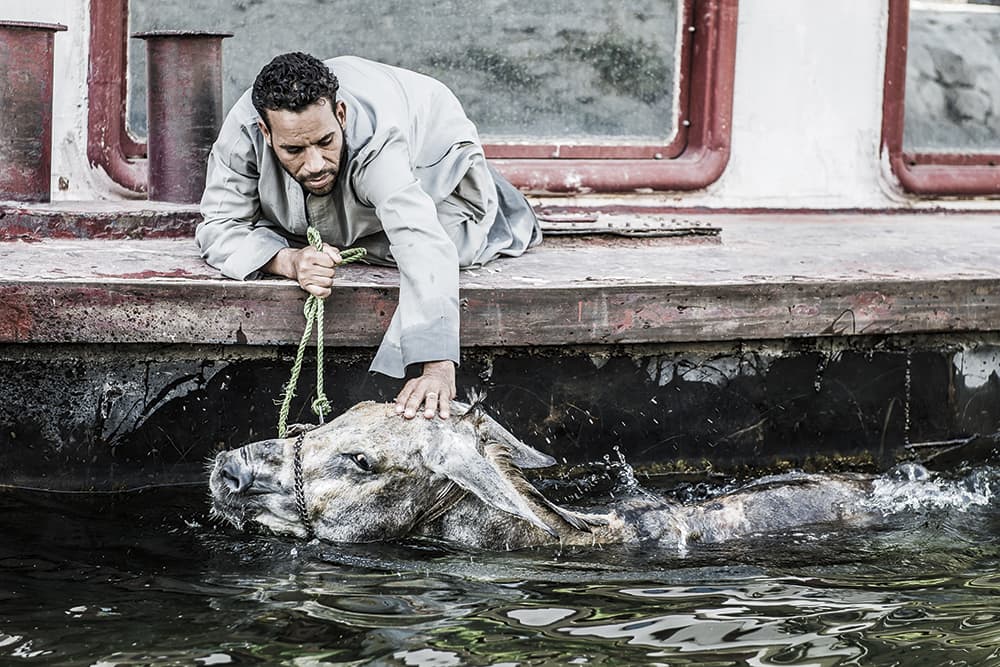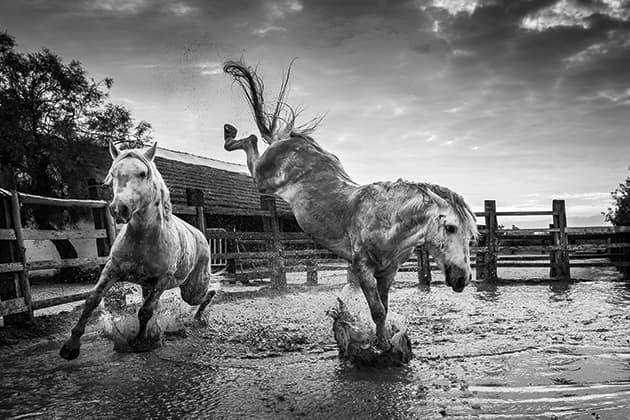Many will recognise Richard Dunwood’s name from his long and illustrious career as a champion jockey – riding to victory multiple times at the Grand National, King George VI Chase and the Cheltenham Gold Cup in 1988, among other accolades. Some may even know him from his stint as a contestant on Strictly Come Dancing. What may be slightly less known is that Richard is currently carving out a successful career as a photographer. His new-found love has taken him all over the world, and he was even invited to speak at this year’s Travel Photographer of the Year (TPOTY) Summer Lectures in London, where he joined the 2014 TPOTY winner Philip Lee Harvey to discuss how budding photographers can follow their passion.
Turning interest into a career
Although Richard has become serious about photography relatively recently, his interest in the craft goes way back. He tells us: ‘I had always enjoyed it. We had a darkroom at school and I did a bit of black & white photography there.’ Richard also found himself surrounded by photographers during his time on the racecourses. ‘When I was riding, I had some friends who were racecourse photographers; my ex-wife worked for one of them (the photographer Mel Fordham), and she eventually became a racecourse professional as well. So I had that interest, and after I retired from racing I started travelling more and more and became interested in getting better images.’
It’s fair to say that racing horses doesn’t leave you with any hands free for taking photos. In fact, Richard describes only one occasion in his 20-year racing career where he took images himself. ‘I remember once, I think it was in Carlisle, Cumbria, going down to the last fence with Mel Fordham about halfway through the afternoon when I didn’t have a ride in a race. I went there, and I used one of his cameras I think – but that was the only time.’
The idea to become a professional photographer occurred quite some time after retirement, though. ‘I was travelling a lot to all sorts of different places,’ Richard explains. ‘I was working with a travel company called Wild Frontiers, which is an adventure travel company. We were travelling a lot to Central Asia. I had one trip through Kyrgyzstan, Tajikistan, Afghanistan and into the Wakhan Corridor [the narrow strip of land in northeast Afghanistan that extends to China and separates Tajikistan from Pakistan]. I was looking for something I could do that combined travel and something I was really interested in – photography.’
In 2011, after reading about it via a friend on Facebook, Richard decided to study a course at the prestigious Spéos Photography School in Paris, France – something that Richard describes as a ‘full-on’ experience.
‘They worked us pretty hard,’ he recalls. ‘There wasn’t just the printing side, but we also learned Lightroom, Photoshop and were sent out on assignments.’ Keen to expand his skills for travel, Richard chose to specialise in photojournalism. ‘I thought it would go more with travel photography than the studio course,’ he explains.
Given his background, it’s not particularly surprising that Richard has ended up taking a lot of equine images, but this doesn’t necessarily mean that horses are his favourite subject. ‘I’ve ended up taking those kinds of images maybe because of what I’ve done in the past. But basically, if anything, I prefer covering other things,’ he reveals. ‘I don’t like to pigeonhole myself as an equine photographer – and there are lots of other great race and equine photographers in England.’
For the past couple of years, Richard has been working closely with Noel Fitzpatrick, better known to many as The Supervet on Channel 4. ‘I haven’t photographed any horses in his surgery – [only] cats, dogs and the odd rabbit,’ says Richard. He admits that there are similarities between the subjects, but with one crucial difference. ‘It’s easier to get to a horse’s-eye level than to get to a dog’s-eye level.’ He jokes: ‘They say you should never work with children or animals, but I try to make things hard for myself.’

Bulls being herded in the Camargue, France, October 2015
Being close to the action
Richard has worked closely with the horse and donkey welfare charity The Brooke. His work includes photographing exciting events such as the Mongol Derby, an equestrian endurance race through the Mongolian Steppe. On examining his photos from events, it would appear that Richard places himself in pretty precarious positions to get the shot, but it’s this closeness to the subject that he believes makes the images worthwhile.
‘I’m always quite aware that you want to get as close as possible, as long as you’re not frightening the horses, which is the number one thing,’ he says. ‘It’s quite good at the start of the race to get close to give as much of a feel of the race. I think it’s important that you do that.
‘I don’t think horses galloping past me is particularly worrying – I’d rather they gallop past me than gallop over the top of me,’ he says, ‘which used to happen quite a lot when I was riding.’
Richard takes inspiration from one of the greats of photography in this philosophy: ‘I think that’s the basic concept of good photography – to try to give a flavour of what it’s really like, to get as close to the subject as possible. Robert Capa said: “If your pictures aren’t good enough, you aren’t close enough.” So that’s the thing I’ve tried to do.’
For other photographers, who may not necessarily have the same kind of background as Richard, he advises experimentation and bringing your style over from other kinds of photography.
‘You can learn other things, and try to adapt other styles,’ he says, ‘For example, I’ve just bought an Elinchrom light and I’m using it to do portraits of both people and horses. I adore portraits, so it’s bringing those skills across.
‘If you’re looking to shoot horses in action,’ he explains, ‘make sure you’ve got a good shutter speed. I would probably go to 1/1,600sec for horses galloping if you want to freeze it. But then just have fun panning. Enjoy taking images at slower speeds, like 1/250sec or 1/125sec as well. Try to mix it up.’

A calèche (carriage) driver washes the head of his mule in the River Nile from a riverboat, Luxor, Egypt, April 2013
Keeping it simple
When it comes to kit, although Richard’s bag is full of professional equipment it’s a relatively minimal set-up. He has three full-frame Nikon DSLRs – the Nikon D4S, D4 and D810. Richard generally uses three zoom lenses – the AF-S Nikkor 14-24mm f/2.8G ED, AF-S Nikkor 24-70mm f/2.8G ED and AF-S Nikkor 70-200mm f/2.8G ED VR II – which he feels match the journalistic style he’s working to.
‘Recently, when covering the Mongol Derby, those three were my main lenses,’ he explains. ‘It was photojournalism really; it was to cover the race and send back images every night by satellite. To record the event and everything going on, those lenses work really for that, with one on each body.’
Richard says he is considering upgrading to the recently announced Nikon D5, but is also tempted by smaller and lighter cameras, such as the Fujifilm X-T2, which he has been using lately.
‘I’ve really enjoyed using [the Fujifilm X-T2] and have been impressed with the high ISO and speed of focusing, so it’s something that I’m eyeing up,’ he says. ‘If you use a camera like the D4S, especially for street photography, it’s not the most discreet thing. So sometimes it makes sense to use smaller cameras. Also, when I’m riding [Richard leads riding holidays], I’ve tried using the D4S and a long lens swinging around my neck and cantering down the road – which is not particularly good for me, the horse or the camera.’
High ISO capability is important to Richard, as a lot of his equine work is taken under low light. ‘The D810 doesn’t handle it quite so well,’ explains Richard, ‘but the D4 and the D4S are good for early morning starts. You also want to use natural light rather than flash, as that would destroy the whole ambience.’
Despite Richard’s extensive travelling, there’s one place he holds in particularly high esteem. ‘I haven’t been there for a couple of years now, but I’ve enjoyed my trips to Afghanistan,’ he says. ‘I’ve probably been there six or seven times since 2008. It’s a beautiful place. It’s tragic what’s happening, but it’s a place where I’ve come back with some cool images in the past, and I’d love to go back and photograph it more in the future.’

A buzkashi match played between Panjshir and Kabul, Afghanistan, 2011
Into the future
Next up for Richard is a trip to Russia to photograph racing for Gallop magazine, after which he’ll be leading some riding holidays in Armenia. Looking further forward, Richard says he’s still working on his photographic style – something he says he hasn’t quite nailed down. ‘I don’t feel it yet, but I’ll keep working at it,’ he says. ‘Give me another few years and I might get there. I’ll keep getting better, that’s the main thing.’
As somebody who has had two completely different careers, it’s easy for Richard to compare the two side by side. But is photography everything he hoped it would be? ‘I’d have to say it’s bloody hard work sometimes, but I love it as well,’ he says. ‘I really enjoy it. I’m competitive, and if some of the images aren’t as good as I feel they should be, then it can have its ups and downs like any other job, but I think I’m very lucky. Nothing will replace horse racing, but producing a good image is sometimes like riding a winner.’
Richard Dunwoody retired as a jockey in 1999, and now works as a photographer across a range of subjects, including equine photography. His work has appeared in global publications including Tatler, Four Seasons Magazine, Outside and How to Spend It. To see more, visit www.richarddunwoodyphotography.com.







